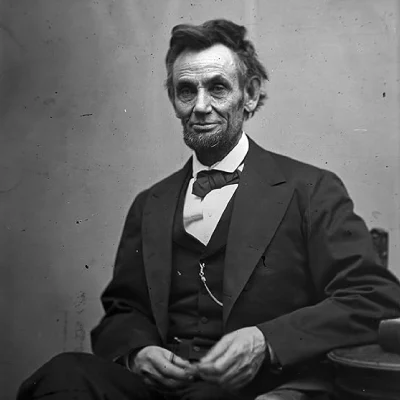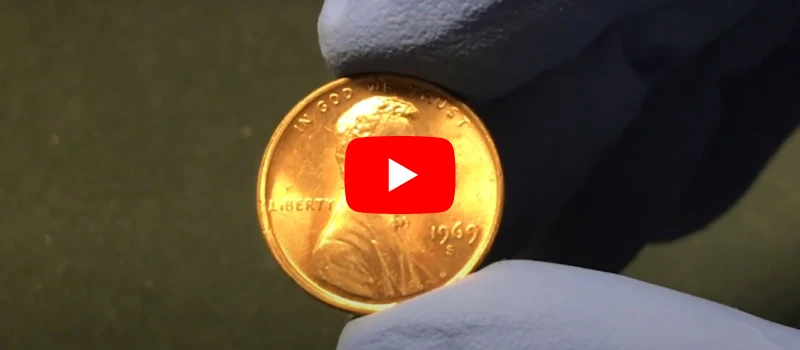In 1969, a significant compositional modification was made to the Lincoln
penny, replacing the traditional 95% copper wheat penny alloy with a new
copper-zinc compound. This crucial change put a stop to the 60-year
production of pennies made of the copper-rich alloy that gave them their
characteristic crimson color. Although most 1969 pennies are common, there
are certain rare variants and transitional faults that are worth more to
collectors.
This in-depth guide will cover the 1969 S penny value, total mintages,
condition price guides, and the factors affecting the 1969 S penny value.
This guide will help you identify and value the most valuable 1969
pennies, whether you're just rolling the dice or collecting a full set of
Lincoln pennies.
In 1969, a significant compositional modification was made to the Lincoln
penny, replacing the traditional 95% copper wheat penny alloy with a new
copper-zinc compound. This crucial change put a stop to the 60-year
production of pennies made of the copper-rich alloy that gave them their
characteristic crimson color. Although most 1969 pennies are common, there
are certain rare variants and transitional faults that are worth more to
collectors.
This in-depth guide will cover the 1969 S penny value, total mintages,
condition price guides, and the factors affecting the 1969 S penny value.
This guide will help you identify and value the most valuable 1969
pennies, whether you're just rolling the dice or collecting a full set of
Lincoln pennies.
History of the 1969-S DDO Lincoln Cent

The sixteenth president of the United States of America was Abraham
Lincoln. He was a staunch abolitionist and is best remembered for the
Emancipation Proclamation, which marked the beginning of the end of
slavery, and his Gettysburg Address.
On April 21, 1865, President Lincoln was assassinated by a sympathizer
of the Confederation. A coin would be minted 44 years later in
memorial to the assassinated president.
The first Lincoln cent was minted in 1909, as that was Abraham
Lincoln's 100th birthday. Victor David Brenner, a sculptor, had been
engaged by the
US Mint
to design the obverse and reverse of the coin.
The reverse has since undergone several modifications, but the
obverse, featuring the president, remained the same since its minting
in 1909. In the initial series, the reverse showed two ears of wheat;
this was changed in 1959 to the Lincoln Memorial Hall.
Lincoln's likeness is on the obverse of the 1969 coin, and the Hall is
on the reverse.
Despite some initial criticism, this cent was successfully introduced
into circulation in August 1909, with minimal issues from the U.S.
Mint. The majority of the population favored the idea of featuring a
U.S. president on the coinage, leading to its widespread acceptance.
The Value Factor: What Makes a 1969 S Penny
Valuable?

There are several factors which can affect the 1969 S Penny value
-
Mint Marks
The Denver, Philadelphia, and San Francisco mints produced the 1969
pennies. Because mint marks reveal the location of a coin's striking,
they have an impact on elements including scarcity, collectibility,
condition, rarity, and historical relevance when determining the price
of Lincoln cents.
Different mintages result in different mint marks being rarer, which
increases demand and raises prices for coins from particular US Mint
branches.
-
Rarity
Coins from the 1969 Lincoln Memorial aren't very rare. The
Philadelphia Mint originally produced 1,136,910,000 units. Denver
struck 4,002,832,200 coins, the most of any city. San Francisco
released 544,375,000 specimens into general circulation, the lowest
mintage quantity.
Nonetheless, it is extremely rare to find surviving examples of these
coins in Superb Gem form and with their original red mint coloring.
There are just a few 1969-S Pennies in MS-68 grade that have been
discovered, and PCGS values them at $10,000!
Sadly, contact marks are now more noticeable due to Lincoln's
portrait's increased features, which limits the supply of coins in
really high grades.
Learn how coin grading impacts a coin's value below.
-
Coin Grading
Assessing a coin's condition and assigning a grade based on a
numerical scale is known as coin grading.
One of the top authorities in coin grading is the Professional Coin
Grading Service (PCGS). It is based on the Sheldon Scale, which was
created in 1948 by Dr. William Sheldon. The scale goes from 1 to 70,
where 1 is a coin that has been severely worn and damaged, and 70 is a
coin that is in mint condition.
The fact that graded coins are trusted by dealers and collectors to
accurately depict their condition underscores the significance of coin
grading in determining a coin's worth. Due to its rarity and
collectors' desire, a higher grade usually demands a higher value on
the market when compared to circulated grades (1 to 50).
Additionally, grading offers a universally accepted means of conveying
the state of a coin, promoting fair trade, and guaranteeing openness
in the marketplace.
Even so, in ordinary circulating conditions, the coin will still be
worth its face value of about one cent.
Furthermore, because their condition is verified by a recognized
grading agency like PCGS and they are frequently housed in protective
slabs, graded coins are frequently more liquid and simpler to sell,
especially in circulated or low-rarity circumstances.
-
Color Designations
The three colors of copper coins are red, reddish-brown, and brown.
Professional numismatists created these classifications, which are
based on how the material responds to different levels of
environmental exposure since it oxidizes as soon as it comes into
contact with air.
How Much is Your 1969 S Penny Worth?

A 1969-S penny value is determined by its variety and condition:
-
1969-S Die Obverse Cent Doubled
This rare variety has been appreciated over time. One sold at auction
for $601,875 in January 2023. The value of the coin is based upon the
strength of the doubling, which ranges in various degrees as the die
is rotated on its axis. The mint mark, the date, and the phrases "In
God We Trust" and "Liberty" are rounded secondary created by the
rotation.
-
Die Cent Doubled Errors
The misprinted pennies can be worth as little as $1,000 or as much as
$85,000, based on their condition.
Conclusion
Given these rare characteristics and the overall significant changes in
its composition, the 1969 S penny portrays both historical and
numismatic value. Most 1969 pennies are common and have only face value;
however, the rare variants and errors are very valuable to collectors.
First and foremost, awareness of the key drivers of value in these coins
should be considered: mint marks, rarity, coin grading, and color
designations. Inside this guide, a seasoned collector and a new
collector alike are furnished with the tools to appreciate and maybe
even uncover the 1969 S penny value.
Happy collecting!
